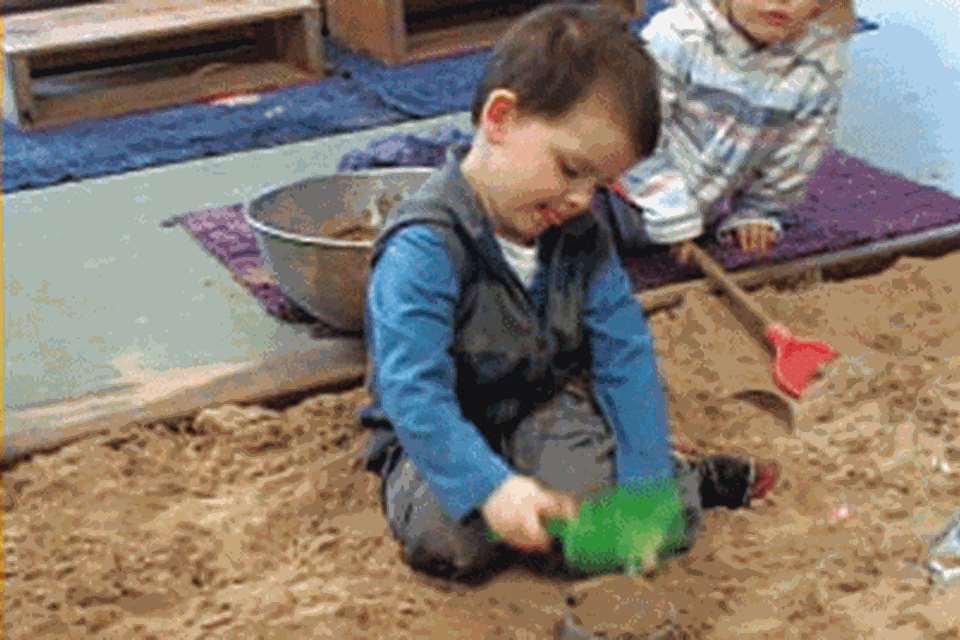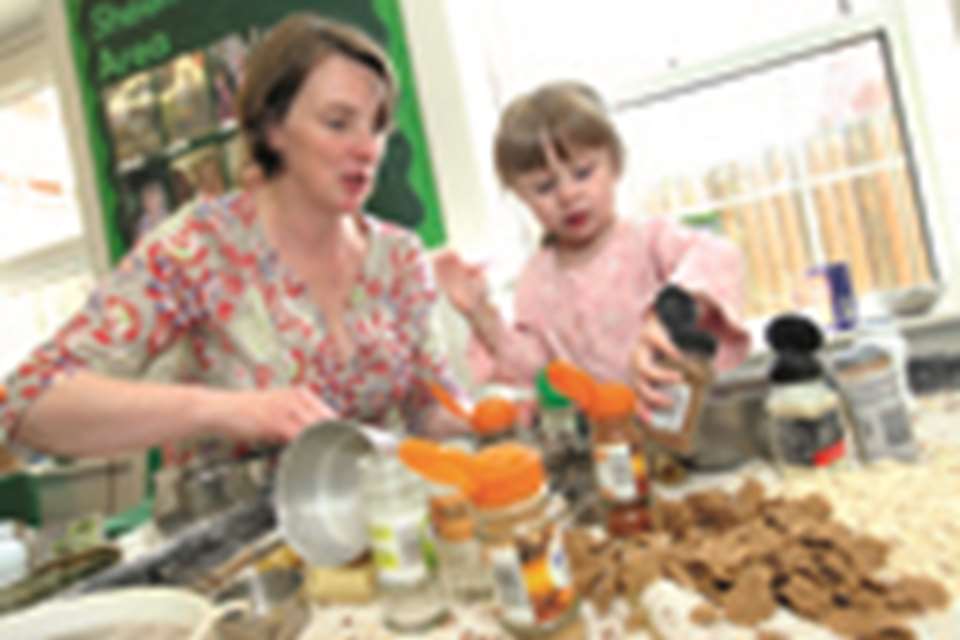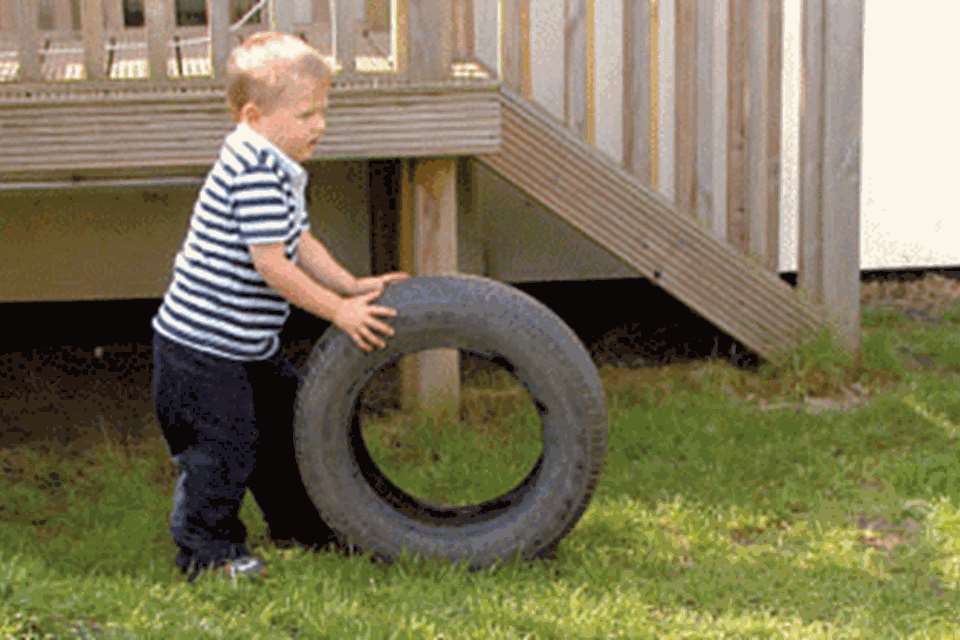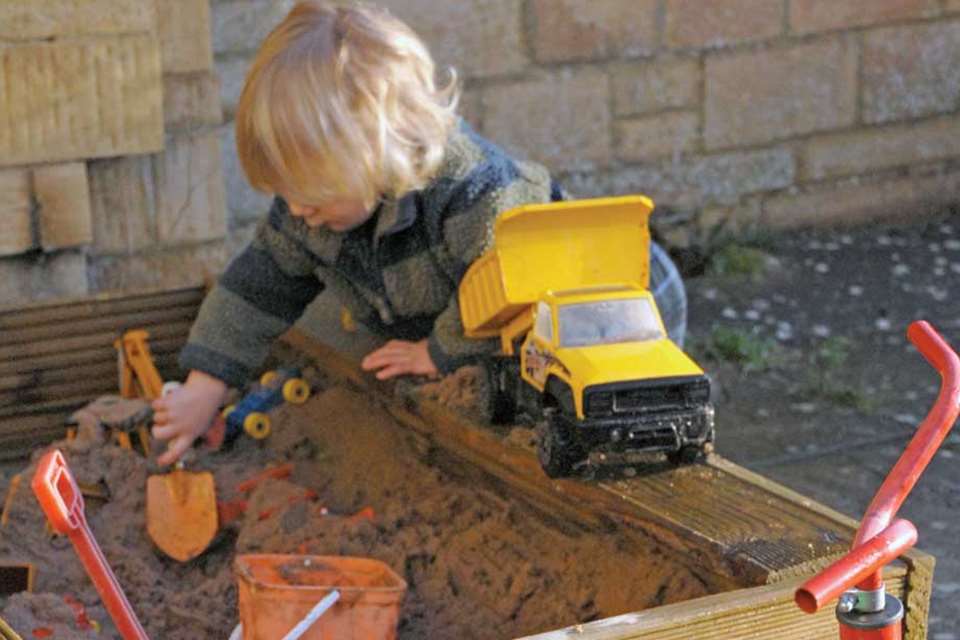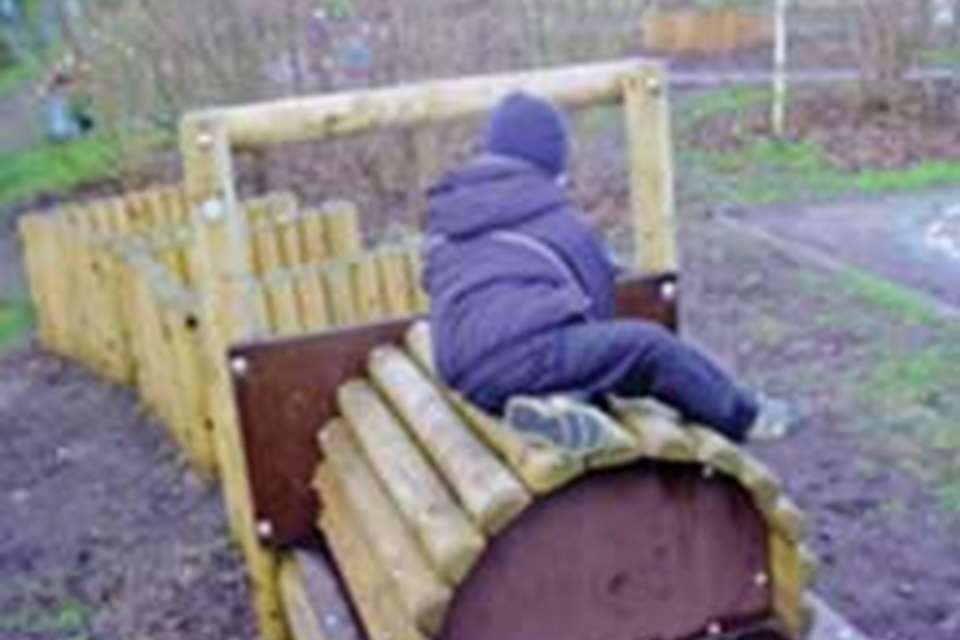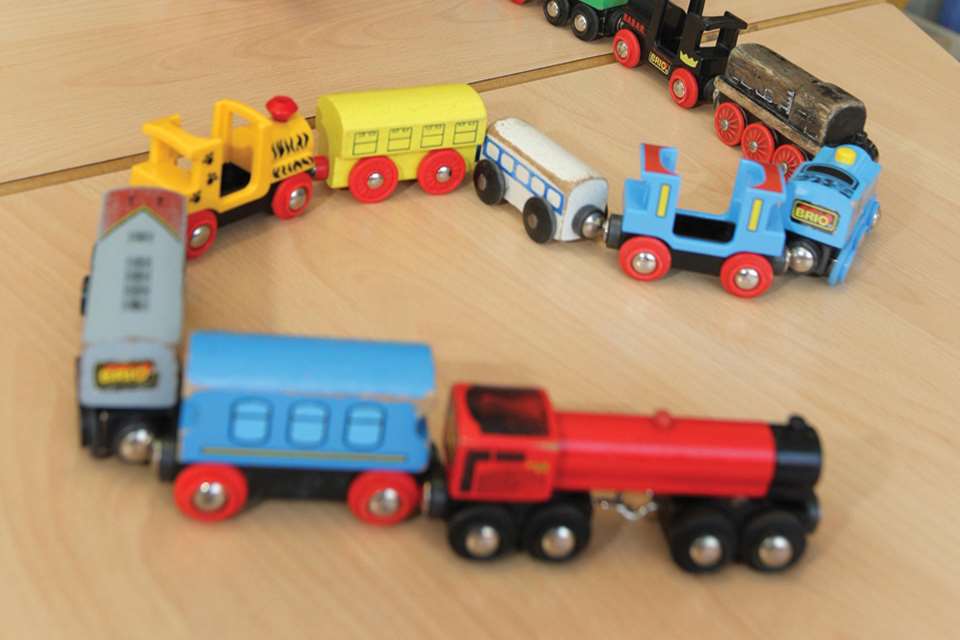EYFS best practice: All about… schematic learning
Professor Tina Bruce CBE, Dr Stella Louis and Dr Carole Bloch
Monday, February 4, 2019
Understanding children’s schemas, or ‘patterns of behaviour and thinking’, enables practitioners to support them as they use them to deepen their learning, explain Professor Tina Bruce CBE, Dr Stella Louis and Dr Carole Bloch

Download the PDF of this article
One of the important challenges for early childhood educationalists is how to explain what significant learning is taking place as babies and young children interact with the people and materials in their setting. What often appear as random explorations can be understood by uncovering repeated behaviours, or ‘schemas’.
These are described as ‘patterns of behaviour and thinking in children that exist underneath the surface features of various contents, contexts and specific experiences’ (Athey 2007). Parents, carers, teachers and researchers familiar with schemas observe children engaging in repeated patterns of trajectory, rotating, enclosing, enveloping, connecting, transporting, orienting, etc.
Schemas arise from and integrate with aspects of both affective (emotional) and cognitive functioning of the brain in a social context. The cognitive functions analyse, recognise patterns, predict possibilities and present possible outcomes, while the affective functions ‘assign values to the different events, outcomes and memories’ and guide the cognitive functions (Ellis and Solms 2018).
An appreciation of the way brain functioning and behavioural schemas intersect helps to explain how early learning happens and provides clues for extending meaningful learning opportunities.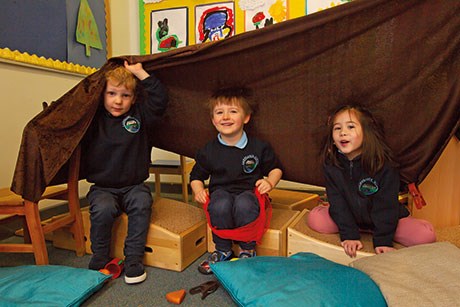
THE NECESSITY OF PLAY
Play is the most natural way in which babies and young children learn. Through play they learn about themselves, others and what they know and can do. Indeed, there is nothing more revealing, often delightful, but sometimes distressing, than the sight of a child absorbed in play. But because it is revealing, it is much more than delightful or distressing. Play is one of the inbuilt emotional instincts in our brains, which means that humans have a propensity to engage in it.
Although play forms part of the affective system we are born with, it depends on the people and experiences met in life for it to emerge and flourish. Young children, like all mammals, will play unless there are constraining complex needs or destabilising influences. It is an inbuilt drive that can usually be triggered. Nature ensures that the possibilities for play are present, but nurture needs to trigger it.
Biologically, play is about ‘finding the limits of what is socially appropriate, tolerable, acceptable, permissible’ (Ellis and Solms 2018). Along with other inbuilt emotional instincts, such as bonding and seeking to understand, play is a key evolutionary survival and learning mechanism (Panksepp 1998, Ellis and Solms 2018). All of the emotional drives undergird learning and intellectual development.
Young children are learning when they repeat activities such as stacking bricks, transporting objects back and forth, emptying and filling containers, mixing things, finding and hiding objects, threading and sorting beads, or drawing. This exploration allows them to make connections, develop skills and solve problems. It also results in play, as we see children being able to demonstrate what they have learnt.
It shows us how children are applying their learning. Play is hugely about the use and application of what has been learnt.
Through play, children learn to express their ideas and feelings, take risks, problem-solve and make mistakes and decisions. They learn to be social, to share, take turns, care for themselves and others, make and mend things and play imaginative games that often involve practising and imitating what they have seen and experienced.
Schematic play and exploration are of fundamental importance in young children’s development and learning; brain plasticity and pattern recognition are two key characteristics of our brains that both enable cognitive functioning and learning. They facilitate the repeated schematic explorations that help ensure well-developed physical and conceptual learning foundations. They combine with prediction, another key characteristic of our brains, to allow babies to learn from experience and develop schemas that summarise expected patterns of interaction.
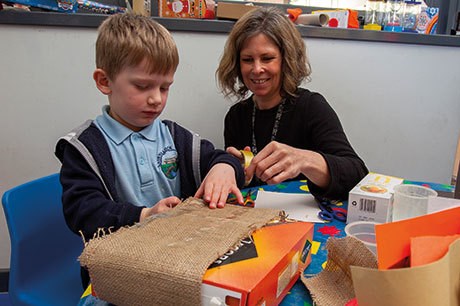
STARTING WITH THE SENSES
Through ongoing observations of children, parents and practitioners will know, often at an implicit level, that schematic behaviours are evident. In the beginning, babies can be observed repeatedly grasping, lifting, sucking, mouthing, kicking, waving and banging. As babies grasp, kick and bang, they explore early schematic actions which scaffold their earliest learning.
These early schematic behaviours become more complex, whereby children can be observed co-ordinating all of their actions. Circular motions and manipulations are initially in the babies’ reflexes. However, when we see toddlers making deliberate circular arm and limb movements, they are displaying related behaviour, which has an underlying pattern running through it. These are developed and refined, later to include rolling, spinning, turning, and these physical and sensory movements co-ordinate with what have been identified as ‘positioning’ and ‘orientation’ schema, (Louis S et al 2012).
Toddlers are often observed putting their thumbs or fingers in and out of their mouths and filling up and emptying containers of all kinds. They seem to relish climbing into boxes, baskets and suitcases, sitting under an apparatus, between small spaces or in tunnels, building enclosures with blocks, painting, or building with fabric. Although these activities may seem unrelated and perhaps only to do with exercising muscles, children are, in fact, working hard on a schematic underlying pattern of behaviour, which is deliberate and systemic.
Their patterns of action and behaviour at this point are related, for example, to scientific understanding of area, estimating size, volume and capacity. Because of another of the emotional drives, the seeking system, this kind of behaviour nurtures young children’s need to find out how their world works.
As with play, this is a shared survival mechanism of all mammals. ‘It motivates the animal to go out and explore, to look for something – anything – interesting and nice. It propels the animal to investigate the world and engage with it, in the firm belief that whatever it needs or wants, it is “out there”’ (Ellis and Solms 2017).
‘Crucially here, as with all instincts, it is the feeling that does the motivating’ (Ellis and Solms 2018). Enthused ‘with energy, curiosity and optimistic expectations’ (Ellis and Solms 2018), as children explore their surroundings they make causal connections, which allow them to form predictions about future possibilities. ‘This is the prototype for all learning. It is profoundly noteworthy that learning is motivated by feelings; it doesn’t just happen’ (Ellis and Solms 2018).
These explorations and play are initiated and happen in social settings through the affiliation system, which starts with mother-baby bonding, and moves outward to include others. When all goes well, this provides the safe and comfortable launching and landing pads that all young children need to learn and thrive.
The skilled educator is able to recognise that these schematic behaviours are meaningful and provide opportunities for groups and individual children. As children journey through schematic stages they develop their reasoning, problem-solving, predicting and theorising, creativity, play narratives, social competencies and interactions, language, literacy, scientific and mathematical thinking (Bruce 1996, 2015). As adults extend and deepen the schematic play with related information, ideas, stories, dialogue or props, they become firm foundations for all future learning.
Practitioners with a good working knowledge of how emotions underpin intellect and how the schematic stages link to children’s thinking are well equipped to provide rich learning opportunities for babies and young children. Below, we explore how schematic development and learning increase in complexity and play an important role in the learning process.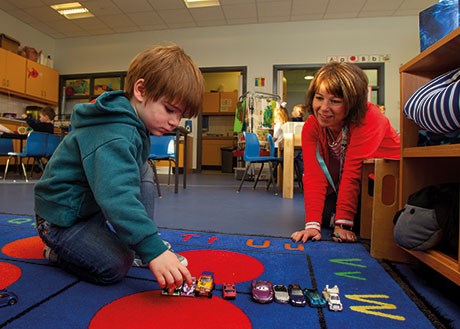
THE SCHEMATIC JOURNEY AND CHILDREN’S THINKING
Through their first-hand experiences and efforts, children’s schematic development progresses into thinking in a specific direction. For example, a child with the trajectory schema might explore lines; move up and down; create lines with vehicles; make up stories; throw leaves in the air; bounce on the sofa, roll balls at skittles and draw lines. Athey (1990) defined the four dynamic ways in which she and Tina Bruce had observed schemas in the research school as:
- Motor actions
- Symbolic functioning
- Functional dependency relationships
- Thought.
Motor actions
Through their senses (what they see, hear, touch, smell and taste), children explore unrelated objects and practise skills depending on their interests, as well as their physical, emotional, mental and social capabilities and needs. This part of the schema journey consists of the child’s unique and individual experiences, derived mainly from sensory schematic exploration. This development is concrete by nature; children are intrinsically motivated as they explore and learn, discovering causal connections, and predicting what will happen next based on previous experiences with people and with materials.
Symbolic functioning
Through the child’s first-hand experiences and play, the schemas, which are biologically driven, emerge, develop and are processed into more schematic concepts. This relates to how children’s early language, communication skills, literacy and symbolic thinking emerge, when they are able to use an object or person to stand for (represent) something or someone either present or absent. For instance, a block may become a car.
The child’s concern here is to take in knowledge, absorb it, assimilate it and later on reproduce it and gain an understanding of the specific relationships and categories. A child’s early symbolic representation, for example, a drawing of a car, would quite possibly be in contrast and look different from a concrete representation of an actual car. Symbolic representation brings forth imaginative play, the precursor to writing and reading (Vygotsky 1978).
Functional dependency relationships
Functional dependency is characterised by a deepening in the understanding of cause and effect. The child begins to work out what happens at the beginning and the result, but also takes account of the steps in between. So, to wash their hands, a child needs to know that putting in the plug and turning on the tap will cause the basin to overflow, rather than fill to the top, unless they take account of the step in the middle – gauging when to turn off the tap. Chris Athey (1990) realised that this is quite complex and moves beyond simple cause and effect to become functional dependency.
When functional dependency develops, so does children’s concern with sorting out relationships, similarities and differences. Here, all the original content based on first-hand experience is arranged into categories, albeit fluid and ever-changing in character, rather than fixed concepts.
The idea of how parts of the vehicle work together are explored as children begin to apply their existing knowledge about the vehicle to new situations that they encounter. For example, a child turning the steering wheel of a toy car to make the wheels turn requires the child to have an understanding of how wheels are linked to each other. Functional dependency enables the child’s understanding that they can do things to make things happen.
The earliest cause-and-effect relationship which precedes functional dependency can be observed when an adult smiles at a child and the child responds by smiling back (Greenspan and Shanker 2004). During the functional dependency stage (or cause and effect), children begin to show understanding that they can make certain things happen by carrying out a set of procedures or actions. Following on from the example of a child wanting to wash their hands, the child may be fascinated to discover that they can make a plug out of paper tissues, rather than using the plastic one. Children often explore how to fill and overflow all the sinks in a setting – not something adults want, but it’s important to understand that this is most likely exploratory, rather than bad behaviour.
Thought
Children begin to reflect upon and become more aware of their own knowledge. For example, in the following conversation with a practitioner, the child noted the effects of getting lots of toilet tissue and stuffing it into the plug. The child said, ‘I put tissue in the plughole and the paper got wet.’ The practitioner asked what happens when you completely block the sink like that. The child said, ‘The water cannot get out.’
Athey (1990) suggests that ‘when children reach the “thought level”, the earlier motor and representational stages with all the content of past experiences are “brought forward” to provide the “form” and “stuff” of thinking’. This means that when children reach the abstract thought stage they can explain exactly how they carried out procedures.
We never leave behind the earlier learning. This continues to be active at every point in the learning journey of life. This means that when children come across problems in their play, they can be observed using functional dependency relationships, symbolic functioning and motor action to find a solution for the problem at hand. It is, therefore, vital that practitioners are aware of the inter-connectivity between these four stages of schematic development, and also that there is no question of the child remaining at one schematic stage only.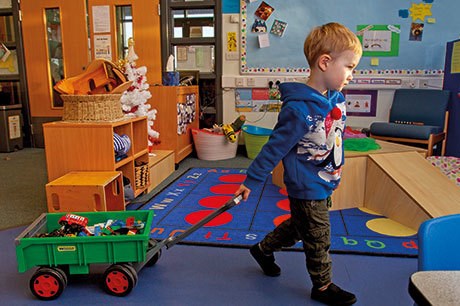
CONCLUSION
Knowledgeable practitioners are aware that emotional systems underpin cognitive brain function and learning and are able to recognise that consistent schema patterns of action are meaningful and how to accommodate them to expand children’s opportunities for learning.
This implies understanding that babies and young children’s innate mechanisms to develop and learn initially involve movement and all of their senses. This leads on towards semi-concrete symbolic experiences which centre around meaning-making and play and include the patterning of rhythmical, repetitious oral language songs, lullabies and rhymes, and the visual images and written language of picture books.
This leads to engagement in full symbolic representation, proceeds to functional dependency and then progresses towards abstract thinking. Children will be observed in the increasingly complex journey of their schematic learning, to be striving to find solutions to the meaning-making challenges they face.
Practitioners facilitate holistic learning when they ensure that children do not perseverate at one schematic stage of functioning. For example, a child with autism who continually ran his finger around the circumference of a plate was gradually introduced to a range of plates, then saucers and cups.
Next he painted around plates, and saucers, then began to spontaneously draw and paint circular enclosures. He began to put objects into the enclosure, such as small-world animals. By observing the enclosure schema, the practitioner was able to expand the range of the use of the schema.
When practitioners are good observers of schemas and support children to make use of them, they can also take a major role in helping children to extend the way the schemas are experienced and used by the child, so that learning is deepened in ways that are appropriate to individual babies and young children’s intrinsic motivation.
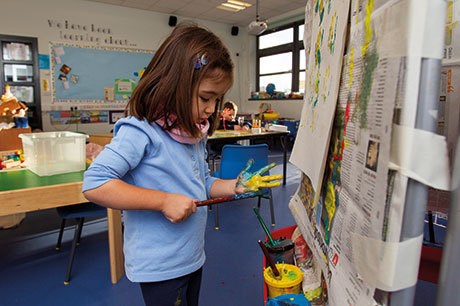
CASE STUDY: Lairhillock Primary School
in Netherley, Aberdeenshire
When Aberdeenshire Local Authority organised schema training led by Dr Stella Louis in 2017, the nursery staff at Lairhillock Primary School jumped at the chance to find out more about an area that they had little knowledge of. They returned to the school enthused by what they had learned and excited to put it into practice.
‘Our practice was already child-led but the training made the staff – who have many years of experience between them – think even more about individual children, how they learn and why. It gave them more knowledge for supporting children and reinforcing their learning,’ says head teacher Christeen Saward. ‘Over a year on and they’re still learning about schemas and finding new ways to support them.’
Gaining an understanding of schemas has enabled the staff to become more reflective and value the children’s individual ways of learning even more. While they have never discouraged children from wrapping themselves in blankets and sitting on cushions in plastic buckets in the story corner, they now appreciate that children may be demonstrating an enveloping schema.
Staff have invested a grant, received because the nursery is extending its hours, in open-ended resources, such as wooden blocks, to support a range of schemas.
Observation and planning
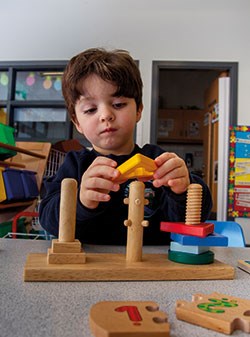 When undertaking planning, they now take the time to observe any schemas, understand how and why a child likes to play in a certain way and then use this to think about what other experiences they can offer to support or extend the child’s learning. For example, one girl has demonstrated a ‘positional’ schema and likes to order items and explore them when positioned in different ways.
When undertaking planning, they now take the time to observe any schemas, understand how and why a child likes to play in a certain way and then use this to think about what other experiences they can offer to support or extend the child’s learning. For example, one girl has demonstrated a ‘positional’ schema and likes to order items and explore them when positioned in different ways.
‘She lines up toys and groups them according to her own personal remit. This very much leant itself to the introduction of sorting, ordering and grouping resources in the nursery, which is a great step towards more formalised learning,’ says Ms Saward.
‘A boy who has been identified as having the “transporter” schema continually moved things around the nursery, using any method of transport he could find – bags, baskets, boxes, his hands. The staff introduced a trailer and he now happily moves items in bulk around the room. He also likes to transport water and the staff are supporting him to meet this challenge!’
She believes that the children are developmentally benefiting from staff having much more insight into how to subtly guide them to their next steps during free-flow play.
Staff have found that talking to parents about their child’s schemas has proved a way of linking with them, explaining how their child enjoys learning and how this can be continued at home. Staff plan to hold a parent’s coffee morning to provide more detailed information.
Ms Saward adds, ‘The nursery team has always been passionate about what they do, but learning about schemas has been like giving them fairy dust and adding more sparkle to their work.’
Lairhillock Primary: Christmas in January
After the first part of our schema training with consultant Stella Louis, we felt uplifted, and returned to school full of ideas about how to respond to children’s schemas, write Rachel May, Sarah Stevenson and Nicky McGachy.
Over the next few weeks, we observed our little charges, with interesting results – especially in the lead-up to Christmas with its high expectations of what children should be doing. We had provided the usual regalia of dressing-up clothes, stockings to fill, a small tree to decorate, and resources for making Christmas cards, shiny collages and writing and posting letters to Santa. All this amid our Nativity play rehearsals.
As Christmas approached, we stood back to observe our busy youngsters and discuss the last day of term when school tradition dictated that all things Christmassy be packed away. As children watch a Christmas movie, staff dash around dismantling the tree, taking down pictures, removing glitter and shiny paper, unwrapping and recycling fake presents, removing the post box and washing, drying and folding up the dressing-up clothes in one of many boxes to be returned to the highest shelf in the store room, not to be seen for another year.
The question of why we do this was raised on our first day of schema training and led to a thought-provoking discussion. As the final day of term loomed, Nicky suggested leaving out all the Christmas resources, to test the theory about children’s schematic learning. What, we asked, was the sense of packing away Christmas things before the actual event and children had had the chance to experience it first-hand? On reflection, we agreed Christmas would remain!
Surprise, surprise!
Apart from a stress-free end of term, the decision proved to be an enriching experience for our children, who returned on 6 January surprised to discover that Christmas was still ‘open’ in our playroom. Our head teacher Christeen Saward was surprised too, as were our parents, but all were keen to see the results.
One way our children learn is through first-hand experiences – such as visiting Santa and posting letters. Such experiences support symbolic representation and, in turn, help the whole child to develop by fostering new skills, language and movement and boosting social and emotional development.
What we observed was a drawing table full of busy letter-writers, chatting about gifts they had received and what had happened in their house. We had a full post box and a very busy Santa reading letters and delivering toys with the help of reindeers and Christmas elves, who transported him around the room on a wheeled box normally used for storage. We saw a group of happy, engaged children role-playing all the wonderful things that had happened in the holidays. We even had Christmas singing once more!
None of the children questioned why Christmas paraphernalia was still out. A couple of parents did, but when we explained schematic learning to them, they could see the reasoning – and the positive results.
Children need time to develop their schemas. Being given the time to embed these patterns of play enriches their learning. It wasn’t until the end of January that one of our boys asked ‘if it was time the Christmas tree went away’. After a chat with the children, it was decided that they would like to close Christmas and play with something else of their choice. As they were still enthusiastic about letter-writing and posting, we provided resources for a post office instead.
Keeping Christmas open is an experience our team would repeat and recommend. After all, why as adults should we suddenly disrupt and pack away our children’s play things purely because it is ‘that time’? This goes against the grain of everything we do as nursery nurses. What gives us the right to stop children’s learning in its tracks? Time to change? We think so, and this year Christmas will again stay open.
Rachel May and Sarah Stevenson are early years practitioners and Nicky McGachy is early years lead practitioner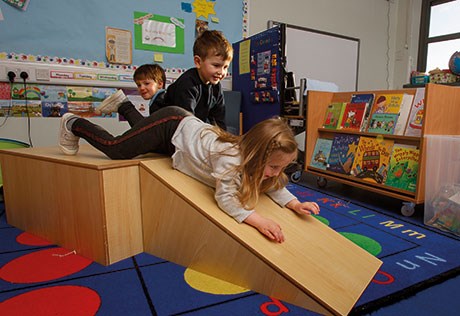
SCHEMATIC LEARNING: SUPPORTING PARENTS AND CARERS
Practitioners need to recognise the crucial role that parents and grandparents play in their children’s early learning and that their involvement contributes in deep ways to children’s success in the early years. So, it is important to run parent workshops that share knowledge of how children may use schemas to explore and express their developing ideas, feelings, relationships and thoughts through their explorations and play.
When parents understand their children’s repeated behaviours are meaningful, they are in an informed position to support it or redirect it. Rather than waiting for their child to move things that they do not want them to move, parents can redirect the play by providing a range of things that the child can transport around the house that will not cause irritation.
When practitioners are able to collaborate with and help parents to feed, nourish and redirect schematic behaviours, they reveal and enrich children’s learning. Parents can be encouraged to support the exploration of a schema cluster by talking with their child about it. For example, a child interested in the movement and direction of trajectories may talk about going backwards and forwards.
As they show interest and offer time, space and resources, a motivating cycle of emotional and cognitive support ensures the child discovers new things and experiences that extends a schema cluster. While many parents are pleased to see their child making covered dens and putting lids on pots, it is less pleasing when they constantly hide objects around the house and get dirty looking underneath things such as rugs – or in the cat litter tray!
However, it becomes potentially empowering and interesting for a caregiver to know that her child is busy learning the envelopment schema. With initial practitioner guidance, parents can spot the schemas and provide children with safe and constructive options to explore.
REFERENCES
Athey C (1990 and 2007) Extending Thought in Young Children: A Parent-Teacher Partnership
Bruce T (1996) Helping Young Children to Play
Bruce T (2015) Early Childhood Education (Sixth Edition)
Ellis G and Solms M (2018) Beyond Evolutionary Psychology: How and Why Neuropsychological Modules Arise
Greenspan I and Shanker S (2004) The First Idea: How symbols, language and intelligence evolved from our primate ancestors to modern humans
Featherstone S (Ed) (2012) Understanding Schemas in Young Children: Again! Again!
Panksepp J (1998)Affective Neuroscience: The Foundations of Human and Animal Emotions
Vygotsky LS (1978) Thought and Language
Dr Carole Bloch is director of Project for the Study of Alternative Education in South Africa (PRAESA), and the adjunct associate professor at University of Western Cape; Dr Stella Louis is an early years consultant and Froebel trainer


